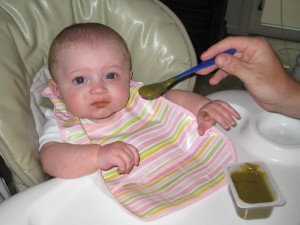Read this guide to learn how much and what you need to feed your kids between 12 to 36 months. Don’t get worried if your kid is eating more or less than the quantity suggested below because they are general guidelines. But, you can consult with your healthcare provider if you see a sudden change in your kid’s eating habits.
According to the American Academy of Pediatrics, children needs to get about 40 calories a day for each inch of their height. Keep reading to know more about what to feed at different ages of your kid.
Age: 12 to 24 months
What to Feed
- Iron-fortified cereals like wheat, oats, mixed cereals, barley, etc.
- Fruits like apricot, melon, grapefruit, papaya, and other soft fruits.
- Vegetables like cauliflower and broccoli after cooking softly.
- Milk.
- Honey.
- Dairy products.
- Protein from eggs, boneless fish, tofu, small pieces of meat, peanut butter, and others.
- Juice (it should be 100 percent juice).
Image via Source
Feeding tips
- Most of the experts recommend that you shouldn’t give eggs, fish and peanuts to young children because it can cause stomach allergy. But, a latest study by the American Academy of Pediatrics found no such evidence. Still, if you want to stay on the safe side, you can consult your healthcare provider before feeding such things to your kids.
- Remember that choking is still a threat.
- Use a spoon to feed your kids.
Age: 24 to 36 months
What to feed
- Low-fat milk. When your kid becomes two years old, it is okay to turn to low-fat milk. Consult your doctor if you have any question in your mind.
- Iron-fortified cereals.
- Dairy products. Try to use a low-fat product like low-fat yogurt, grated cheese, etc.
- Fruits (as per your choice, but finely slice them). At this stage, you can also start dry fruits if you are interested and they are easily available.
- Grains
- Cut various veggies and cook them well before serving.
- Juices (100 percent juice of veggies or fruits)
- Protein from eggs, peanut butter, boneless fish, poultry, tofu, and others.
- Combo foods like cheese, casseroles, and macaronis.
Feeding tips
- At this stage, you can start self-feeding if you and your child is interested. Self-feeding is helpful in a way that you don’t need to sit around your kid every time to feed. Also, you can do a lot of stuff while he or she is eating.
- During this stage, kids to have a strong opinion towards various foods. They start liking and disliking various foods because of one reason or another. Allow your kid to tell you about his or her choices, but make sure that you keep a balance in their diet.
Image via Source
For Vegetarians
In case, you are a vegetarian and you want to feed your kids with veggies only, we have something special for you. The American Academy of Pediatrics and Academy of Nutrition and Dietetics confirm that it is completely okay to feed your kids with veggies only.
All you need to make sure is that your kid gets enough nutrients of the following list:
- Vitamin D: For the babies who breastfed, you need to provide an extra 400 IU per day from cow or soy milk.
- Calcium: calcium-fortified foods are must required for vegan babies.
- Iron: Iron-fortified cereals or supplements are a good source of Iron. Provide more vitamin C rich foods to help in iron absorption.
- Fiber: Grain bread, pastas, fortified cereals are a good source of fiber. High fat plants like avocados and sunflower are also rich in fiber.
- Vitamin B12: Vegan lovers can complete the needs of this vitamin through eggs and milk products. Also, meat substitutes, cereals, and soy beverages can fulfill the needs of Vitamin B12
Feature Image via Source
 Mums and Bubs
Mums and Bubs







